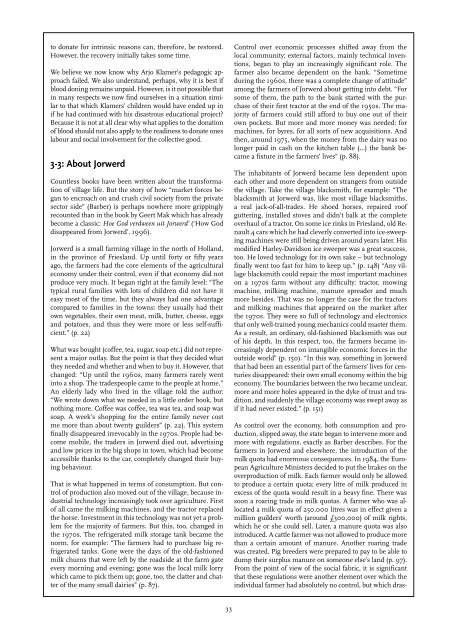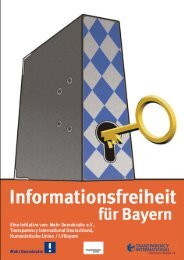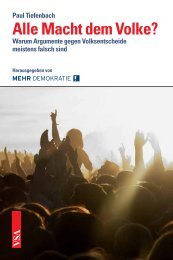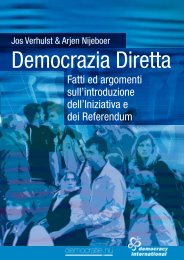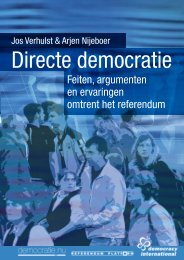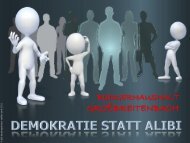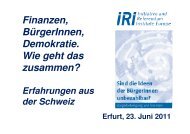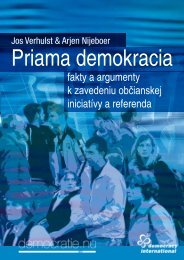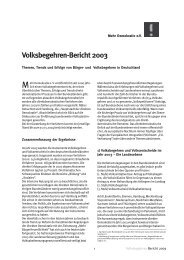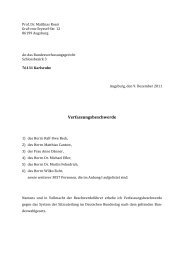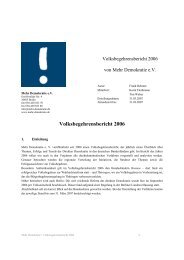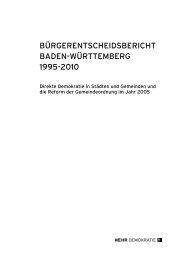Facts and Arguments about the Introduction of Initiative and ...
Facts and Arguments about the Introduction of Initiative and ...
Facts and Arguments about the Introduction of Initiative and ...
Create successful ePaper yourself
Turn your PDF publications into a flip-book with our unique Google optimized e-Paper software.
to donate for intrinsic reasons can, <strong>the</strong>refore, be restored.<br />
However, <strong>the</strong> recovery initially takes some time.<br />
We believe we now know why Arjo Klamer’s pedagogic approach<br />
failed. We also underst<strong>and</strong>, perhaps, why it is best if<br />
blood doning remains unpaid. However, is it not possible that<br />
in many respects we now find ourselves in a situation similar<br />
to that which Klamers’ children would have ended up in<br />
if he had continued with his disastrous educational project?<br />
Because it is not at all clear why what applies to <strong>the</strong> donation<br />
<strong>of</strong> blood should not also apply to <strong>the</strong> readiness to donate ones<br />
labour <strong>and</strong> social involvement for <strong>the</strong> collective good.<br />
3-3: About Jorwerd<br />
Countless books have been written <strong>about</strong> <strong>the</strong> transformation<br />
<strong>of</strong> village life. But <strong>the</strong> story <strong>of</strong> how “market forces began<br />
to encroach on <strong>and</strong> crush civil society from <strong>the</strong> private<br />
sector side” (Barber) is perhaps nowhere more grippingly<br />
recounted than in <strong>the</strong> book by Geert Mak which has already<br />
become a classic: Hoe God verdween uit Jorwerd’ (‘How God<br />
disappeared from Jorwerd’, 1996).<br />
Jorwerd is a small farming village in <strong>the</strong> north <strong>of</strong> Holl<strong>and</strong>,<br />
in <strong>the</strong> province <strong>of</strong> Friesl<strong>and</strong>. Up until forty or fifty years<br />
ago, <strong>the</strong> farmers had <strong>the</strong> core elements <strong>of</strong> <strong>the</strong> agricultural<br />
economy under <strong>the</strong>ir control, even if that economy did not<br />
produce very much. It began right at <strong>the</strong> family level: “The<br />
typical rural families with lots <strong>of</strong> children did not have it<br />
easy most <strong>of</strong> <strong>the</strong> time, but <strong>the</strong>y always had one advantage<br />
compared to families in <strong>the</strong> towns: <strong>the</strong>y usually had <strong>the</strong>ir<br />
own vegetables, <strong>the</strong>ir own meat, milk, butter, cheese, eggs<br />
<strong>and</strong> potatoes, <strong>and</strong> thus <strong>the</strong>y were more or less self-sufficient.”<br />
(p. 22)<br />
What was bought (c<strong>of</strong>fee, tea, sugar, soap etc.) did not represent<br />
a major outlay. But <strong>the</strong> point is that <strong>the</strong>y decided what<br />
<strong>the</strong>y needed <strong>and</strong> whe<strong>the</strong>r <strong>and</strong> when to buy it. However, that<br />
changed: “Up until <strong>the</strong> 1960s, many farmers rarely went<br />
into a shop. The tradespeople came to <strong>the</strong> people at home.”<br />
An elderly lady who lived in <strong>the</strong> village told <strong>the</strong> author:<br />
“We wrote down what we needed in a little order book, but<br />
nothing more. C<strong>of</strong>fee was c<strong>of</strong>fee, tea was tea, <strong>and</strong> soap was<br />
soap. A week’s shopping for <strong>the</strong> entire family never cost<br />
me more than <strong>about</strong> twenty guilders” (p. 22). This system<br />
finally disappeared irrevocably in <strong>the</strong> 1970s. People had become<br />
mobile, <strong>the</strong> traders in Jorwerd died out, advertising<br />
<strong>and</strong> low prices in <strong>the</strong> big shops in town, which had become<br />
accessible thanks to <strong>the</strong> car, completely changed <strong>the</strong>ir buying<br />
behaviour.<br />
That is what happened in terms <strong>of</strong> consumption. But control<br />
<strong>of</strong> production also moved out <strong>of</strong> <strong>the</strong> village, because industrial<br />
technology increasingly took over agriculture. First<br />
<strong>of</strong> all came <strong>the</strong> milking machines, <strong>and</strong> <strong>the</strong> tractor replaced<br />
<strong>the</strong> horse. Investment in this technology was not yet a problem<br />
for <strong>the</strong> majority <strong>of</strong> farmers. But this, too, changed in<br />
<strong>the</strong> 1970s. The refrigerated milk storage tank became <strong>the</strong><br />
norm, for example: “The farmers had to purchase big refrigerated<br />
tanks. Gone were <strong>the</strong> days <strong>of</strong> <strong>the</strong> old-fashioned<br />
milk churns that were left by <strong>the</strong> roadside at <strong>the</strong> farm gate<br />
every morning <strong>and</strong> evening; gone was <strong>the</strong> local milk lorry<br />
which came to pick <strong>the</strong>m up; gone, too, <strong>the</strong> clatter <strong>and</strong> chatter<br />
<strong>of</strong> <strong>the</strong> many small dairies” (p. 87).<br />
33<br />
Control over economic processes shifted away from <strong>the</strong><br />
local community; external factors, mainly technical inventions,<br />
began to play an increasingly significant role. The<br />
farmer also became dependent on <strong>the</strong> bank. “Sometime<br />
during <strong>the</strong> 1960s, <strong>the</strong>re was a complete change <strong>of</strong> attitude”<br />
among <strong>the</strong> farmers <strong>of</strong> Jorwerd <strong>about</strong> getting into debt. “For<br />
some <strong>of</strong> <strong>the</strong>m, <strong>the</strong> path to <strong>the</strong> bank started with <strong>the</strong> purchase<br />
<strong>of</strong> <strong>the</strong>ir first tractor at <strong>the</strong> end <strong>of</strong> <strong>the</strong> 1950s. The majority<br />
<strong>of</strong> farmers could still afford to buy one out <strong>of</strong> <strong>the</strong>ir<br />
own pockets. But more <strong>and</strong> more money was needed: for<br />
machines, for byres, for all sorts <strong>of</strong> new acquisitions. And<br />
<strong>the</strong>n, around 1975, when <strong>the</strong> money from <strong>the</strong> dairy was no<br />
longer paid in cash on <strong>the</strong> kitchen table (...) <strong>the</strong> bank became<br />
a fixture in <strong>the</strong> farmers’ lives” (p. 88).<br />
The inhabitants <strong>of</strong> Jorwerd became less dependent upon<br />
each o<strong>the</strong>r <strong>and</strong> more dependent on strangers from outside<br />
<strong>the</strong> village. Take <strong>the</strong> village blacksmith, for example: “The<br />
blacksmith at Jorwerd was, like most village blacksmiths,<br />
a real jack-<strong>of</strong>-all-trades. He shoed horses, repaired ro<strong>of</strong><br />
guttering, installed stoves <strong>and</strong> didn’t balk at <strong>the</strong> complete<br />
overhaul <strong>of</strong> a tractor. On some ice rinks in Friesl<strong>and</strong>, old Renault<br />
4 cars which he had cleverly converted into ice-sweeping<br />
machines were still being driven around years later. His<br />
modified Harley-Davidson ice sweeper was a great success,<br />
too. He loved technology for its own sake – but technology<br />
finally went too fast for him to keep up.” (p. 148) “Any village<br />
blacksmith could repair <strong>the</strong> most important machines<br />
on a 1970s farm without any difficulty: tractor, mowing<br />
machine, milking machine, manure spreader <strong>and</strong> much<br />
more besides. That was no longer <strong>the</strong> case for <strong>the</strong> tractors<br />
<strong>and</strong> milking machines that appeared on <strong>the</strong> market after<br />
<strong>the</strong> 1970s. They were so full <strong>of</strong> technology <strong>and</strong> electronics<br />
that only well-trained young mechanics could master <strong>the</strong>m.<br />
As a result, an ordinary, old-fashioned blacksmith was out<br />
<strong>of</strong> his depth. In this respect, too, <strong>the</strong> farmers became increasingly<br />
dependent on intangible economic forces in <strong>the</strong><br />
outside world” (p. 150). “In this way, something in Jorwerd<br />
that had been an essential part <strong>of</strong> <strong>the</strong> farmers’ lives for centuries<br />
disappeared: <strong>the</strong>ir own small economy within <strong>the</strong> big<br />
economy. The boundaries between <strong>the</strong> two became unclear,<br />
more <strong>and</strong> more holes appeared in <strong>the</strong> dyke <strong>of</strong> trust <strong>and</strong> tradition,<br />
<strong>and</strong> suddenly <strong>the</strong> village economy was swept away as<br />
if it had never existed.” (p. 151)<br />
As control over <strong>the</strong> economy, both consumption <strong>and</strong> production,<br />
slipped away, <strong>the</strong> state began to intervene more <strong>and</strong><br />
more with regulations, exactly as Barber describes. For <strong>the</strong><br />
farmers in Jorwerd <strong>and</strong> elsewhere, <strong>the</strong> introduction <strong>of</strong> <strong>the</strong><br />
milk quota had enormous consequences. In 1984, <strong>the</strong> European<br />
Agriculture Ministers decided to put <strong>the</strong> brakes on <strong>the</strong><br />
overproduction <strong>of</strong> milk. Each farmer would only be allowed<br />
to produce a certain quota; every litre <strong>of</strong> milk produced in<br />
excess <strong>of</strong> <strong>the</strong> quota would result in a heavy fine. There was<br />
soon a roaring trade in milk quotas. A farmer who was allocated<br />
a milk quota <strong>of</strong> 250,000 litres was in effect given a<br />
million guilders’ worth (around £300,000) <strong>of</strong> milk rights,<br />
which he or she could sell. Later, a manure quota was also<br />
introduced. A cattle farmer was not allowed to produce more<br />
than a certain amount <strong>of</strong> manure. Ano<strong>the</strong>r roaring trade<br />
was created. Pig breeders were prepared to pay to be able to<br />
dump <strong>the</strong>ir surplus manure on someone else’s l<strong>and</strong> (p. 97).<br />
From <strong>the</strong> point <strong>of</strong> view <strong>of</strong> <strong>the</strong> social fabric, it is significant<br />
that <strong>the</strong>se regulations were ano<strong>the</strong>r element over which <strong>the</strong><br />
individual farmer had absolutely no control, but which dras-


